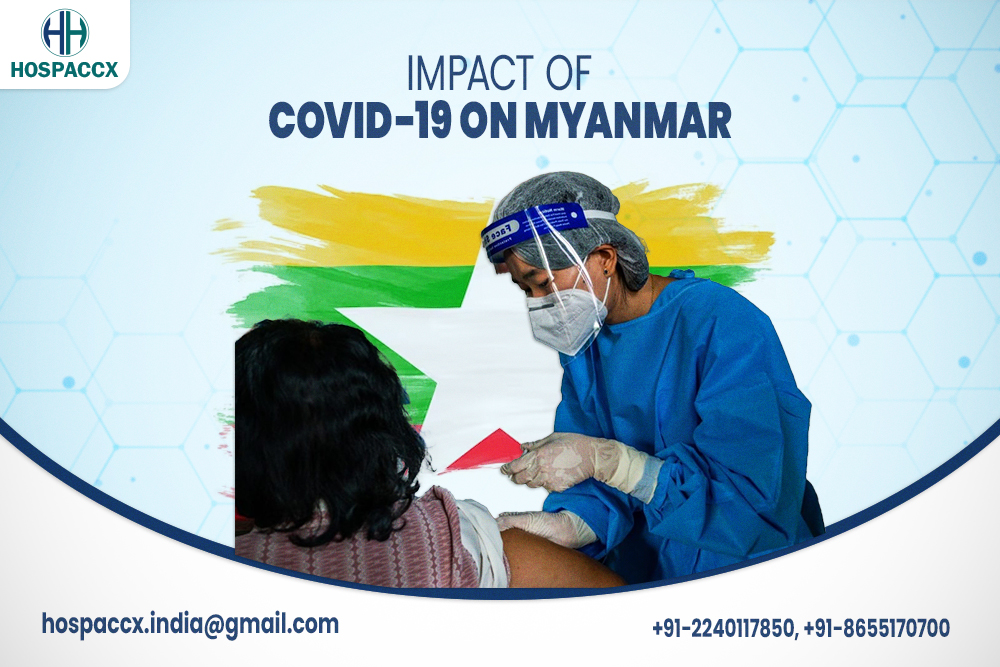Are you wondering about the impact of the COVID pandemic on Myanmar? As a person of interest in healthcare investments, are you curious to know how Myanmar’s healthcare sector persevered during the difficult times of COVID? Are you aware of the measures that were taken, in order to ensure continuity of service delivery?
Hospacxx Healthcare Consultancy, presents to you details on the scenario of the COVID pandemic in Myanmar, especially with respect to their healthcare sector and the changes that were made to fulfill the increased demands for healthcare service delivery.
INCIDENCE OF COVID PANDEMIC
Myanmar was first affected with COVID-19 around the month of March 2020, right after the rapid increase of cases in China. According to a study by Myo Min Oo et. al.; about the spread of COVID-19 across Myanmar, the country was especially vulnerable to the spread of COVID-19 because of its 2227-km porous border with China, where migrant workers cross daily, as well as borders shared with Bangladesh, India, and Thailand, all of which reported higher number of cases.
As of 2022, there is total of 612,864 affected with COVID, out of which, 19,434 cases led to death and 591,794 cases were recovered from the infection.
COVID-19 INFLUENCE ON THE COUNTRY
- Governance: – According to a study by Myo Min Oo et. al.; about the spread of COVID-19 across Myanmar, it was reported that as an early response to the COVID-19 breakout, before the World Health Organization (WHO) declared it as a global health emergency, the Myanmar Government initiated the formation of the Inter-Ministerial Working Committee. Right after, A National Central Committee was formed to prevent, control and treat COVID-19. These committees aimed at smoothing out and fast-tracking activities at the central level such as case investigation and management, providing community awareness and disseminating updates regarding the pandemic, and securing funding, procurement of essential medicine and equipment in time.
After detection of the first two cases, strict containment measures were implemented which included travel restrictions, partial lockdowns, closure of major businesses such as factories and shopping malls, quarantining incoming travelers, banning gatherings of five or more people, imposing stay-at-home orders, and curfews in some major cities. The Closure of borders and enforcement of mandatory quarantine, either in a state-sponsored facility or a charity-based one, were also intensified.
With the added burden of COVID-19 pandemic, the country’s situation had become a complete chaos. As a former state under an almost 50-year rule of an oppressive military junta, known as the Tatmadaw, Myanmar once again was forced to come under the rule of the military dictatorship since the country returned into a military state from a quasi-democratic political system on 1 February 2021, in the midst of an ongoing public health emergency, after 10 years of a series of political reforms and civilian rule.
Due to the increasing friction between the civilian government and the Tatmadaw over alleged election irregularities, Aung San Suu Kyi, the re-elected state counsellor of Myanmar, was arrested, along with other key officials, in a morning raid. Despite the ongoing pandemic, the military declared a coup, putting Myanmar under a 1-year state of emergency. Subsequently, the state power was transferred to the commander-in-chief of the Armed Forces, Min Aung Hlaing.
- Economy: – The COVID-19 pandemic and government lockdown in Myanmar have led to the decline in exports and revenue from tourism and international payments, hitting the economy hard. According to a study by XINSHEN DIAO AND MICHAEL WANG for the journal “COVID-19 AND GLOBAL FOOD SECURITY”, the analysis showed a major short-term economic contraction as a result of the two-week lockdown in April, with a 41% decline in GDP along with similar declines in most nonagricultural sectors in comparison to the same period without a pandemic.
Such an impact results from Myanmar’s economy being deeply integrated into a complex supply network for both domestic and international trade, and policies that affected certain industries which have ripple effects on other sectors through supply and demand linkages. In addition, approximately 4 million Myanmar migrants worked internationally, and their lost income due to lockdowns in neighboring countries was expected to impose ongoing significant burdens on low-income households that receive remittances.
IMPACT OF THE COVID PANDEMIC ON THE HEALTHCARE SECTOR
Myanmar’s health sector was already challenged by common health problems faced in developing countries, including shortage of skilled health care workers and underfunded health infrastructure. According to a research study, Myanmar’s health care consistently ranks the world’s lowest and it was included in 57 countries facing critical health workforce shortages.
Health Infrastructure and Manpower: – According to the 2019 Global Health Security Index, Myanmar was least prepared in terms of the availability of health systems to treat the sick and protect health care workers. Myanmar had just 6.7 physicians per 10,000 people in 2018, significantly lower than the global average of 15.6 physicians per 10,000 people in 2017. Besides, it only had 10.4 hospital beds per 10,000 people. In March 2020, Myanmar reported just 0.71 intensive care unit beds and 0.46 ventilators per 100,000 population, which were insufficient to deal with even a moderate outbreak.
The government had increased surge capacity by constructing makeshift hospitals, quarantine centers, and clinics; and procuring ventilators and securing funding for ICU units. But these efforts were compromised by the scarcity of medical staff. The government had called upon volunteers to work at state quarantine centers, but mandatory 14-day quarantine and increasing caseloads had stressed volunteers. In addition, some of the quarantine centers were reportedly poorly managed, increasing the transmission risk in centers; 10 percent of the total confirmed cases in the second wave were among health care workers.
Thus, health care workers had been greatly affected by COVID-19 compared to other professions as they are directly responsible for the well-being of patients. Health workers are challenged by issues, such as exhaustion due to heavy workload, inadequacy or lack of personal protective equipment (PPEs) and the fear of getting and/or spreading the infection. In Myanmar, 14 health workers have been infected with COVID-19.
The coup had indeed significantly affected the country’s healthcare system. There have been reports of doctors being dismissed from their posts, being arrested and hiding in fear for their lives—signifying a grave breach of humanitarian law. Moreover, health infrastructure was also affected. It was reported that The Grand Hantha International Hospital, which was situated near a police station in Yangon, exploded in April 2021.
COVID Testing & Vaccinations: – The testing capacity was initially limited to only two facilities, but later extended to another three facilities including that of the military sector. All these rendered a huge blow on the frail health system and limited the response to COVID-19. According to a study by Ian Christopher Rocha et. al., it was reported that a few days after the coup, the daily new cases abruptly dropped to one or two digits every day. This is attributed to the hampered COVID-19 testing in the country as a result of the turmoil. Due to the military coup and the collapsed healthcare system, the real COVID-19 situation in the country is thought to be unreliably reported.
In addition to the collapse of the COVID-19 testing and response, the COVID-19 vaccination progress in Myanmar had trickled down since the expelling of the Democratic government, as frontline health workers refused to get vaccinated unless there is no involvement from the military junta. The healthcare system had been disorganized as some health sectors in Myanmar continue to strike along with the uneven boycott system from the public. Consequently, with decline in the trust for the vaccination process, there was more decline in vaccination of the general public, as a result of the widespread anger at the Myanmar regime, with more of its people refusing to get vaccinated.
Pharmaceutical & Biomedical Technology: – The Association of South East Asian Nations (ASEAN) had handed over USD 1.1 million worth of medical supplies and equipment ready to be distributed by the Myanmar Red Cross Society (MRCS) for immediate support to the COVID-19 response. They further called for other countries to contribute to the humanitarian efforts as Phase 1 urgently and Phase 2 at a later stage. The next batch for Phase 1 is expected to be provided by support from Brunei Darussalam, Cambodia, Singapore and Viet Nam, along with other donor countries and organizations.
According to a report by the Indian Express, India also provided 200,000 hydroxychloroquine tablets and other medical equipment to Myanmar to aid its fight against the deadly coronavirus. Besides the 200,000 antimalarial hydroxychloroquine tablets, the medical supplies include surgical gloves, body bags, minor surgical sets and thermal scanners.
The Military coup in Myanmar has caused severe damage on the COVID-19 response of the country, and the action has been condemned by various world leaders due to the continuing escalation of violence among its people. Despite several mass protests, the country has failed to achieve solidarity in a time where health and safety should have been given greater focus. This has therefore hampered the ability of the country and its people to tackle the issues brought about by the COVID-19 pandemic, especially with the infection rates being underestimated since the start of the coup.
The same health system is already struggling to cope with the conventional health demands. Thus, careful consideration should be given to resource re-allocation, alleviating health system exhaustion and upgrading health staff capacity.
CONCLUSION
Although the Myanmar government had rapidly implemented containment measures and public health responses, the country had experienced one of the most severe COVID-19 outbreaks in Southeast Asia by late 2020. Concerns about Myanmar’s vulnerability to the pandemic were raised by the United Nations due to its weak healthcare infrastructure following poor investment over six decades of military rule, as well as ongoing internal conflict. Thus, the government should seek investments for key health services from public-private partnerships, and international development organizations, increase human resources in the health sector, and consider moving appropriate health services to virtual platforms.
Hospacxx Healthcare Consultancy, likewise, has worked across Indian and International States on Hospital Projects for Business Process Development, Service Quality Assurance, Financial Management and more. For more information, you can visit the company website on www.hospaccxconsulting.com or contact us directly
Related Team Members










